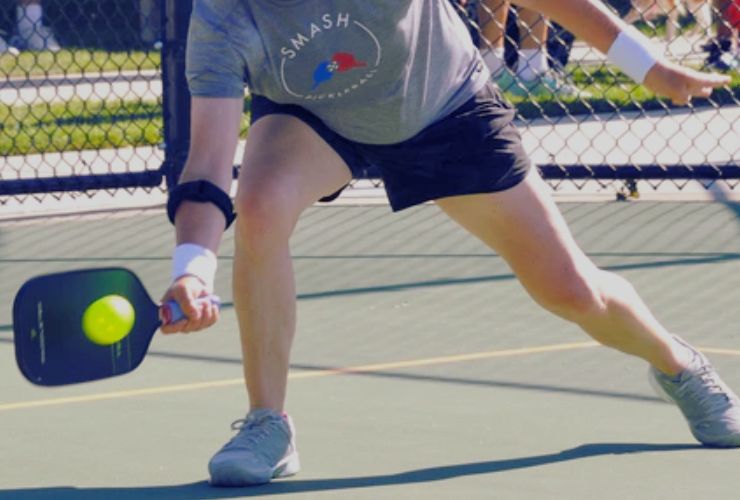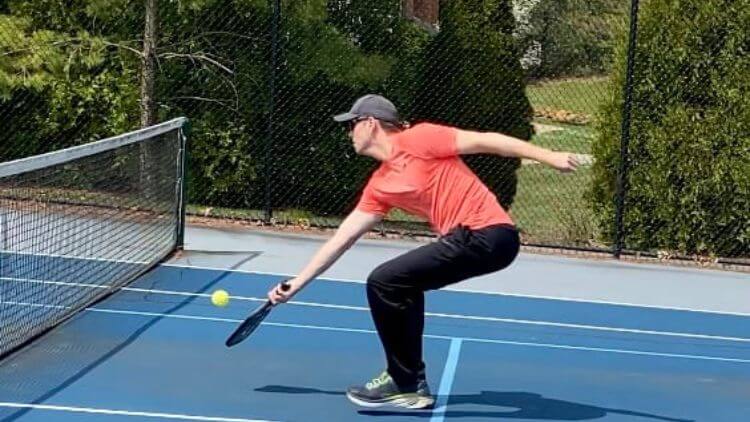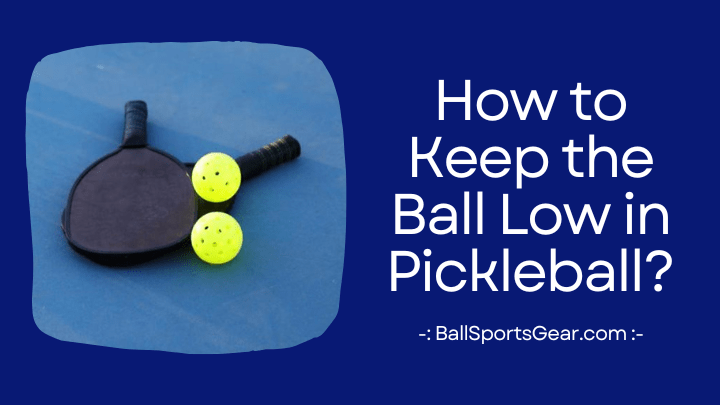People of all ages and ability levels may enjoy the fun and thrilling game of pickleball. How to Keep the Ball Low in Pickleball? The ability to keep the ball low is one of the most important pickleball techniques to perfect since it may help you manage the game’s tempo and keep your adversaries on their toes. Whether you’re a pickleball newbie or an advanced player trying to improve your game, we’ll go over some tips and tricks for keeping the ball low in this article.
How to Keep the Ball Low in Pickleball?
Pickleball takes a mix of strong skill and mental concentration to keep the ball low. If you want to succeed in pickleball, you must learn how to keep the ball low. The following advice will assist you in keeping the ball low:
Check The Grip Pressure
Since they are new to the game and may not be as collected as more seasoned players, beginners frequently struggle to keep a strong hold on their palms. Hitting high balls as a result of this issue may result in more offensive plays. Overly forceful play might also reduce the force of your strokes, leading them to cross the line or strike the net.
Longer rallies may make it challenging for you to have a relaxed hold on your paddle since your body will start to stiffen up. However, it’s crucial to intentionally loosen your grip when you see that it’s influencing the direction and force of your strokes. Avoid gripping your paddle too hard, as if you were trying to keep it from flying away from you.
Keep Your Paddle Angle As Low As Possible
Maintaining a low ball trajectory in pickleball relies on your ability to control the angle of your paddle. When you strike the ball with an upward paddle angle, it will go upward, and conversely, a downward angle will keep it low. Thus, reducing the paddle angle is crucial for achieving a low shot.
To start, assume the ready position and hold the paddle at chest height in front of you. Gradually decrease the angle of your paddle, which will result in the ball traveling in a shallow arc rather than popping up. The flatter your paddle angle, the lower the ball will stay during play.
Avoid having an “open paddle face,” where your paddle is aimed completely upward, as this will cause the ball to bounce straight up. To prevent this, rotate your wrist counterclockwise to close the paddle face. This adjustment will allow the ball to clear the net while minimizing its upward trajectory.
Practice is key to mastering this skill. During scrimmages or wall ball sessions, observe the angle of your paddle after each shot and make slight adjustments to gauge their impact on the ball’s movement.
Engage in drills with a partner by standing at the kitchen line while they hit hard shots from the baseline. This exercise will require you to adapt the paddle angle, control the ball’s speed, and experiment with different angles to keep your returns as low as possible.
With consistent practice, controlling the angle of your paddle will become second nature, enabling you to consistently keep the ball low in competitive settings.
Keep Mind Relaxed
Consistent practice is key to enhancing your pickleball skills, increasing your confidence and comfort on the court. To elevate your game, focus on two important aspects: relaxation and grip.
Relaxation plays a vital role in executing better shots and keeping the ball in play. By consciously relaxing your body, you can achieve smoother and more controlled movements. Relax your muscles, particularly in your arms and shoulders, allowing for a fluid and natural swing. This relaxed state will enable you to react swiftly and adjust your shots accordingly.
Implementing these tips will improve your dinking and hitting abilities, ensuring the ball stays within the court boundaries. As you continue to practice, you will witness noticeable progress in your overall gameplay, leading to increased success on the pickleball court.
Do Not Catch Direct Shots
It’s crucial to avoid catching straight strokes when playing pickleball in order to maintain a low trajectory. The natural tendency could be to grab and return the ball when your opponent hits it directly at you. To keep the ball low, this strategy does not work well.
Positioning oneself to allow the ball to bounce should be your first concern. Allow the ball to touch the ground by moving out of the way. When it bounces, make your shot by moving downward. You can successfully keep the ball low and manage its trajectory by doing this.
You will be able to keep the ball low in pickleball by adopting this technique and doing it consistently, which will enhance shot placement and boost your performance on the court.
Hit The Ball Out In Front Of You
In pickleball, catching the ball in front of you is essential for maintaining your strokes. Every point counts, but if you don’t make contact with the ball while it’s in front of you, it will be tough to make the finest shot.
If you watch experienced players, you’ll notice that they continuously strike the ball in front of themselves since it gives their strokes the most strength. It could be simpler to hit the pickleball if you’ve played a similar game before. For newcomers, repetition and practise are essential for learning this ability.
Importance of Keeping the Ball Low in Pickleball

Pickleball players should aim for a low ball trajectory for several reasons. Firstly, hitting the ball low makes it more challenging for the opponent to return it with power. The opponent must stoop to reach the ball, putting them in a disadvantageous position.
Control over the speed and flow of the game
Maintaining lowball control also provides the player more influence over the tempo and flow of the game. By hitting the ball low, a player can make their rival play defensively, allowing them the chance to control the point and set the tempo of the contest.
Reducing the effects of wind
Additionally, a low ball trajectory might lessen the effect of wind on the ball’s route. Wind is more likely to disrupt high shots, which might reduce their range and accuracy. The player can have better control over their shots and lessen the impact of the wind by hitting the ball low.
In summary, prioritizing a low ball trajectory is an effective strategy for success in pickleball. By practicing and honing this skill, players can enhance their overall gameplay and increase their chances of winning on the court.
Angles That Keep the Pickleball Low at 3 Points of Contact
- Focusing on the angles at the three points of contact: The paddle, the ball, and the ground—will help you hit a low shot in pickleball. You may successfully make it difficult for your opponent to block your shots by taking these angles into account. Here are a few advices:
- Keep your paddle face flat or just slightly tilted downward. This will provide you the ability to strike the ball lower, boosting your chances of making a low shot.
- Ball angle: Aim for a modest upward angle while striking the ball, but don’t hit it too high. A high shot will come from overhitting the ball since it will take longer to travel and lose momentum.
- Ground angle: Aim to hit the ball right as it starts to rise after bouncing as you take your shot. By using this method, you may reduce the angle at which you strike the ball, lowering the height of your stroke.

Keep your pickleball shots low to make it harder for your opponent to return them by using a downward motion with a little upward ball angle and hitting the ball as it rises from the bounce.
Frequently Asked Questions
A: Maintaining a low ball trajectory in pickleball is crucial because it increases the difficulty for opponents to effectively return the ball. A low shot travels over the net with a flatter trajectory, making it challenging for opponents to generate power and angle on their shots.
A: Several techniques can help achieve a low ball in pickleball. These include using a compact and abbreviated swing, employing a closed paddle face, and aiming shots towards the middle of the court. Utilizing slice shots that generate backspin can also keep the ball low.
A: To improve your ability to keep the ball low in pickleball, focus on refining your technique and footwork. Practice slice shots and aim for specific targets on the court. Engaging in drills with a partner who can provide feedback and assist in adjusting your technique is also beneficial.
A: Certainly! There are numerous drills to enhance the skill of keeping the ball low in pickleball. For instance, you can engage in back-and-forth exchanges of low shots with a partner. Another drill involves hitting drop shots and quickly advancing to hit the ball before it bounces twice. Additionally, practicing slice shots while aiming for specific targets on the court is helpful.
A: Common errors when trying to keep the ball low in pickleball include excessive wrist usage in swings, hitting the ball too hard, and aiming for the sidelines instead of the middle of the court. It’s also important to be mindful of your opponent’s position and adjust your shots accordingly, rather than solely focusing on hitting the ball low at all times.
Conclusion
In conclusion, How to Keep the Ball Low in Pickleball? requires mastering the right techniques and dedicating practice to develop consistency. Factors such as grip, form, balance, power, and spin play a vital role in keeping the ball low. Engaging in drills like the dink and drop shot can aid in improving this skill. It is crucial to maintain focus on the ball, ensuring clean and accurate hits. With commitment and perseverance, you can excel in keeping the ball low, ultimately gaining a competitive advantage in your pickleball game.

